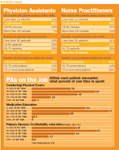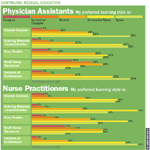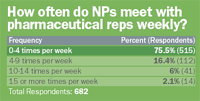Invisible Prescribers: What You Do and Don't Know About NPs and PAs
Pharmaceutical Executive
Before a pharmaceutical company dispatches a sales rep to a medical practice, the marketing department learns some basic facts about the physician: how many new prescriptions she's written, how many refills, and how much upside prescribing growth she might generate. What the rep usually doesn't know: who else-nurse practitioners and physician assistants-prescribes medications in the office, at a nearby clinic, or sometimes in a separate practice just down the hall.
Before a pharmaceutical company dispatches a sales rep to a medical practice, the marketing department learns some basic facts about the physician: how many new prescriptions she's written, how many refills, and how much upside prescribing growth she might generate. What the rep usually doesn't know: who else—nurse practitioners and physician assistants—prescribes medications in the office, at a nearby clinic, or sometimes in a separate practice just down the hall. The rep could make another sales call, but for a variety of reasons he usually does not. Physician assistants and nurse practitioners remain poorly recognized, and therefore rarely courted by pharma. One barrier to marketing to these clinicians is simple lack of prescribing data. Information offered for sale by the big data providers frequently excludes nurse practitioners and physician assistants. And in the pharmaceutical industry, where there is no data, there is no marketing.

Current Prescribing Patterns
Pharmaceutical companies not only fail to market to this sector, they neglect to invite nurse practitioners and physician assistants to meetings or to include them in plans for continuing medical education. Most practitioners must complete 100 hours of continuing education every two years. By not counting nurse practitioners and physician assistants among valued prescribers, pharma misses the opportunity to shape the practice of these professionals.
Even when pharmaceutical companies set out to target this market, they are often uncertain how to address nurse practitioners and physician assistants. Their practices vary dramatically in scope and orientation, which makes it difficult for sales reps to develop consistent messages.

Patient Care
And in many cases, pharma's own rules get in the way of the sales force.
Reps are often charged with adhering to rigorous call schedules—many aim to see eight or 10 physicians a day—which leaves them little time to interact with nurse practitioners and physician assistants. And at many companies, rules dictate that reps do not receive "credit" for a sales call if they spend time detailing nurse practitioners and physician assistants.

Continuing Medical Education
In fact, pharma marketing policies regarding these medical professionals are often stricter than state laws. Manufacturers frequently restrict reps from sampling anyone but doctors, even though laws in all 50 states and US commonwealths set conditions under which nurse practitioners and physician assistants can accept, sign for, and dispense medication samples. So manufacturers' own physician-only signature policies hamper reps' ability to develop relationships with other clinicians.
Whatever the difficulties, pharma is missing a good-sized market. More than 100,000 nurse practitioners and nearly 60,000 physician assistants currently practice. Just 40 years ago, nurse practitioners and physician assistants were rarely found anywhere but rural settings, which were severely underserved by physicians, and in the military, as medics.

How often do NPs meet with pharmaceutical reps weekly?
Today, both disciplines have growing membership associations with outstanding national and regional leadership. Physician-assistant and nurse-practitioner associations lobby Congress and work closely with state boards of medicine to advance their causes. They have accredited training schools—collegiate and postgraduate—with rigorous admissions and graduation requirements.
The earliest academic programs in both disciplines graduated their first classes in 1965. Since then, tremendous changes within the industry, practice patterns, and models of care have enabled nurse practitioners and physician assistants to expand their roles as professional healthcare providers and bring increasing value to medical practices across the country.
Today, many of these clinicians attain additional credentials through post-collegiate study, CME, CE, and practice certifications in a variety of specialty disciplines.
In some areas of medicine, they are increasingly recognized as key opinion leaders, credible authors, expert reviewers, researchers, or partners.
The available data on prescribing patterns of physician assistants and nurse practitioners are often buried within various reporting structures. Such information is difficult to access in the first place, and is also hard to evaluate, especially if a manufacturer wants to attribute prescribed pharmacologic therapies to clinicians. Multiple state boards complicate uniformity and reciprocity, making sales subject to rules and regulations that vary from state to state.
Perhaps most importantly, the roles of nurse practitioners and physician assistants vary dramatically from one place to the next.
In some areas, they function independently in solo practices. In others, they work collaboratively as members of a larger healthcare team. In all settings, however, they are recognized as highly qualified healthcare providers.
Inconsistencies in the way physician assistants and nurse practitioners practice have also kept them under manufacturers' radar when it comes to provider-targeted education. However, that has slowly begun to change.
For one thing, pharma sales managers have labeled increasing numbers of physicians "Do Not See." So sales reps are being forced, in some cases, to turn their attention to nurse practitioners and physician assistants if they want to train all office prescribers in best practices of counseling, medication, or other aspects of patient care.
But even as pharma's motive to call on this influential group of practitioners grows stronger, there is still too little data. Last year, in an attempt to shed light on prescribing and practice behaviors, MEBN, a continuing medical education provider, conducted a survey among nurse practitioners (n=697) and physician assistants (n=172) in order to better understand the unique profile of these clinicians.
The survey obtained current data regarding patient visits, length of time seeing patients, and other important practice facts. Statistics such as these, including prescribing by nurse practitioners and physician assistants, should prompt pharmaceutical manufacturers to take notice of this virtually untapped source of prescribers.
Fully 95 percent of responding nurse practitioners spend 11 minutes or more with their patients during routine office visits. They have time to discuss medication usage, compliance, comorbidities, and behavioral elements of care. Almost half of the respondents (48 percent) indicated that much of their time is spent in medication education.
More than a third (36 percent) report spending large amounts of time conducting physical exams, while 38 percent provide comorbidity counseling as well as primary-disease lifestyle and dietary education. Primary care physicians, on the other hand, report spending an average two to five minutes with patients.
If nurse practitioners see an average of 50 patients per week, the 100,000 nurse practitioners in the United States would have a quarter billion patient visits if they all worked 50 weeks a year. In fact, the number of patients seen in a year could easily be higher. One in four nurse practitioners sees more than 75 patients a week.
Once again, assuming 100,000 nurse practitioners working 50 weeks a year, nurse practitioners would write 125 million prescriptions per year, if they all wrote just 25 prescriptions per week. That number could also be higher; more than a third of all nurse practitioners write more than 50 prescriptions a week.
The AAnurse practitioner, in their 2003 member survey, reports that nurse practitioners write prescriptions in very specific categories, often by brand name, in a wide variety of settings. (www.aanp.org)
Like nurse practitioners, physician assistants spend a great deal of productive time with patients during routine visits.
Two of five physician assistants indicated they spent more than 30 percent of their patient time conducting physical exams. One in three spends as much time on primary-disease and comorbidity education (including diet and lifestyle).
Almost one in four physician assistants spent 30 percent of all patient time on medication education, while another 45 percent spent at least one hour in six advising patients about medications.
If physician assistants see an average of 50 patients per week, the 60,000 physician assistants in the United States would have 150 million patient visits if they all worked 50 weeks a year.
In fact, the number of patients seen in a year could easily be higher, since almost one in three physician assistants sees more than 75 patients a week. Together, physician assistants and nurse practitioners take at least 400-million patient visits a year. Using conservative assumptions, 60,000 physician assistants writing 25 prescriptions a week for 50 weeks would write 75 million prescriptions per year. Added to the estimated 125 million prescriptions written by nurse practitioners, these largely overlooked clinicians may write 200 million prescriptions a year.
Off the Radar
Three in four nurse practitioners report meeting between one and four times a week with pharmaceutical sales representatives. One in three nurse practitioners reports spending more than five minutes with reps each time they call. Seven of eight say they spend more than two minutes with pharmaceutical reps per visit. By comparison, industry analysts estimate that primary care physicians are called on 80 to 100 times per week by pharma sales reps.
Frequently, the doctor does not see the sales representative, but when she does, she spends, on average, between 30 seconds and two minutes in a sales discussion. As the number of "no-see" physicians continues to rise, the number of successful details will continue to decline, diminishing the actual time available for reps to spend in discussion with physicians.
More than four in five physician assistants meet with pharma reps between one and four times per week. More like physicians, many physician assistants take very short meetings with pharmaceutical representatives. Only one physician assistant in four reported spending 5 minutes or more with sales reps.
More than four in five physician assistants meet with pharma reps between one and four times per week. More like physicians, many physician assistants take very short meetings with pharmaceutical representatives. Only one physician assistant in four reported spending 5 minutes or more with sales reps.
About 85 percent of nurse practitioners and physician assistants believe pharmaceutical companies recognize them. Which means that roughly 24,000 prescribers feel they are off big Pharma's radar screen.
Pharma needs to put resources and energy into connecting with these clinicians, and restoring productive relationships.
Continuing Medical Education
Nurse practitioners and physician assistants use a variety of educational programs for continuing education, including case studies, small-group discussions, journal articles, Internet courses, and conference lectures.
The Medical Education Broadcast Network survey respondents were asked to indicate their degree of preference for five different learning methodologies (see table).
More than two of three nurse practitioners preferred—at least somewhat—conference lectures, the Internet, and enduring materials, such as journal articles, over small-group discussions or case studies. Two of the three asked said they are willing to pay for their continuing medical education; 37 percent indicate that they will rely on online courses for their future professional education.
Asked to indicate their degree of preference for five different learning methodologies, more physician assistants-—nearly two in five—favored conference lectures, the Internet, and enduring materials more than small-group discussions or case studies.
Fifty-five percent of physician assistants also said that they would be willing to pay for their continuing education; nearly half said that they will most likely rely on online courses for their future professional education.
Meeting the Market Halfway
Nurse practitioners and physician assistants are not only big prescribers, they report high compliance levels among their patients. Two out of three clinicians say at least half of their patients comply with medication treatment plans. In too many cases, prescriptions written by physicians and other providers are never filled.
Because nurse practitioners and physician assistants spend time educating patients about medication, their prescriptions are more likely to be filled than many written by other providers. When patients do not comply, both types of clinician report, the main reasons are financial problems and simple denial.
In addition to spending time with patients, nurse practitioners and physician assistants are willing to devote time to visits from pharmaceutical representatives. This offers a tremendous opportunity for pharmaceutical manufacturers.
If 160,000 high-prescribing doctors were more willing than most to see sales reps, they would be at the top of every call list. The pharma industry needs to rethink its call-time allocations and raise the per-call value of detailing nurse practitioners and physician assistants.
Sharyn Lee
(sharyn.lee@mebn.net) is CEO of Medical Education Broadcast Network.

Addressing Disparities in Psoriasis Trials: Takeda's Strategies for Inclusivity in Clinical Research
April 14th 2025LaShell Robinson, Head of Global Feasibility and Trial Equity at Takeda, speaks about the company's strategies to engage patients in underrepresented populations in its phase III psoriasis trials.
Beyond the Prescription: Pharma's Role in Digital Health Conversations
April 1st 2025Join us for an insightful conversation with Jennifer Harakal, Head of Regulatory Affairs at Canopy Life Sciences, as we unpack the evolving intersection of social media and healthcare decisions. Discover how pharmaceutical companies can navigate regulatory challenges while meaningfully engaging with consumers in digital spaces. Jennifer shares expert strategies for responsible marketing, working with influencers, and creating educational content that bridges the gap between patients and healthcare providers. A must-listen for pharma marketers looking to build trust and compliance in today's social media landscape.